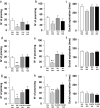Detrimental effects of the 'bath salt' methylenedioxypyrovalerone on social play behavior in male rats
- PMID: 32506112
- PMCID: PMC7547114
- DOI: 10.1038/s41386-020-0729-5
Detrimental effects of the 'bath salt' methylenedioxypyrovalerone on social play behavior in male rats
Abstract
Methylenedioxypyrovalerone (MDPV) is the most popular synthetic cathinone found in products marketed as 'bath salts', widely abused among teenagers and young adults. Synthetic cathinones have pharmacological effects resembling those of psychostimulants, which are known to disrupt a variety of social behaviors. However, despite the popular use of MDPV by young people in social contexts, information about its effects on social behavior is scarce. To investigate the impact of MDPV on social behavior at young age, and the underlying neurobehavioral mechanisms, we focused on social play behavior. Social play behavior is the most characteristic social behavior displayed by young mammals and it is crucial for neurobehavioral development. Treatment with MDPV reduced social play behavior in both juvenile and young adult male rats, and its play-suppressant effect was subject to tolerance but not sensitization. As the behavioral effects of MDPV have been ascribed to dopaminergic and noradrenergic neurotransmission, and given the role of these neurotransmitters in social play, we investigated the involvement of dopamine and noradrenaline in the play-suppressant effects of MDPV. The effects of MDPV on social play were blocked by either the α2 adrenoceptor antagonist RX821002 or the dopamine receptor antagonist flupenthixol, given alone or together at sub-effective doses. In sum, MDPV selectively suppresses the most vigorous social behavior of developing rats through both noradrenergic and dopaminergic mechanisms. This study provides important preclinical evidence of the deleterious effects of MDPV on social behavior, and as such increases our understanding of the neurobehavioral effects of this popular cathinone.
Conflict of interest statement
The authors declare no competing interests.
Figures





Similar articles
-
Discriminative stimulus effects of 3,4-methylenedioxypyrovalerone (MDPV) and structurally related synthetic cathinones.Behav Pharmacol. 2021 Aug 1;32(5):357-367. doi: 10.1097/FBP.0000000000000624. Behav Pharmacol. 2021. PMID: 33587482 Free PMC article.
-
Pharmacology of novel synthetic stimulants structurally related to the "bath salts" constituent 3,4-methylenedioxypyrovalerone (MDPV).Neuropharmacology. 2014 Dec;87:206-13. doi: 10.1016/j.neuropharm.2014.02.016. Epub 2014 Mar 2. Neuropharmacology. 2014. PMID: 24594476 Free PMC article.
-
3,4-Methylenedioxypyrovalerone: Neuropharmacological Impact of a Designer Stimulant of Abuse on Monoamine Transporters.J Pharmacol Exp Ther. 2020 Aug;374(2):273-282. doi: 10.1124/jpet.119.264895. Epub 2020 May 8. J Pharmacol Exp Ther. 2020. PMID: 32385092 Free PMC article.
-
Neurotoxicology of Synthetic Cathinone Analogs.Curr Top Behav Neurosci. 2017;32:209-230. doi: 10.1007/7854_2016_21. Curr Top Behav Neurosci. 2017. PMID: 27753008 Free PMC article. Review.
-
Behavioral pharmacology of designer cathinones: a review of the preclinical literature.Life Sci. 2014 Feb 27;97(1):27-30. doi: 10.1016/j.lfs.2013.10.033. Epub 2013 Nov 11. Life Sci. 2014. PMID: 24231450 Free PMC article. Review.
Cited by
-
Early Life Social Isolation Dysregulates Social Reward Processing, BDNF Signaling, and Intracellular Vesicular Sorting in the Nucleus Accumbens of Male and Female Rats.J Neurochem. 2025 Aug;169(8):e70181. doi: 10.1111/jnc.70181. J Neurochem. 2025. PMID: 40762328 Free PMC article.
-
Synthetic Cathinones and Neurotoxicity Risks: A Systematic Review.Int J Mol Sci. 2023 Mar 25;24(7):6230. doi: 10.3390/ijms24076230. Int J Mol Sci. 2023. PMID: 37047201 Free PMC article.
-
Molecular Mechanisms of Action of Novel Psychoactive Substances (NPS). A New Threat for Young Drug Users with Forensic-Toxicological Implications.Life (Basel). 2021 May 14;11(5):440. doi: 10.3390/life11050440. Life (Basel). 2021. PMID: 34068903 Free PMC article. Review.
-
Sex and Gender Differences in the Effects of Novel Psychoactive Substances.Brain Sci. 2020 Sep 3;10(9):606. doi: 10.3390/brainsci10090606. Brain Sci. 2020. PMID: 32899299 Free PMC article. Review.
-
To Play or Not to Play? Effects of Playmate Familiarity and Social Isolation on Social Play Engagement in Three Laboratory Rat Strains.bioRxiv [Preprint]. 2024 Nov 15:2024.11.14.623692. doi: 10.1101/2024.11.14.623692. bioRxiv. 2024. PMID: 39605718 Free PMC article. Preprint.
References
-
- Karila L, Lafaye G, Scocard A, Cottencin O, Benyamina A. MDPV and alpha-PVP use in humans: the twisted sisters. Neuropharmacology. 2018;134:65–72. - PubMed
-
- Valente MJ, Guedes de Pinho P, de Lourdes Bastos M, Carvalho F, Carvalho M. Khat and synthetic cathinones: a review. Arch Toxicol. 2014;88:15–45. - PubMed
-
- Ashrafioun L, Bonadio FA, Baik KD, Bradbury SL, Carhart VL, Cross NA, et al. Patterns of use, acute subjective experiences, and motivations for using synthetic cathinones (“bath salts”) in recreational users. J Psychoact Drugs. 2016;48:336–43. - PubMed
-
- Zawilska JB, Wojcieszak J. Designer cathinones-an emerging class of novel recreational drugs. Forensic Sci Int. 2013;231:42–53. - PubMed
Publication types
MeSH terms
Substances
LinkOut - more resources
Full Text Sources
Research Materials

